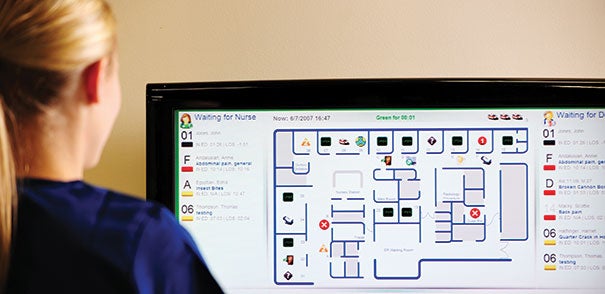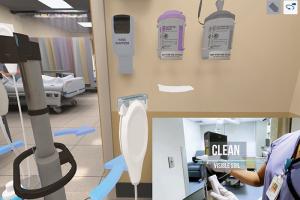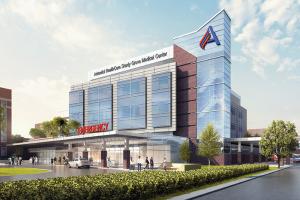Monitoring hospital operations
 |
| PHOTO COURTESY OF AWAREPOINT This RTLS map screen allows staff to locate patients when they are being moved for procedures such as X-rays or CT scans. |
The concept of a context-aware hospital is rooted in the need to improve patient care, increase operational efficiency and reduce capital and operational costs. All of these goals have an impact on revenue related to reimbursement, and are partially driven by HCAHPS patient satisfaction scores.
By deploying context-aware systems based on real-time locating system (RTLS) technology, health care organizations can accomplish many of these goals by integrating into the workflow such information as location and status of medical equipment and staff.
A context-aware hospital can track assets as they move throughout the facility and provide event-driven tracking as they exit and enter areas.
System architecture
At the root of RTLS is radio-frequency identification (RFID), which is often supplemented by other technologies like infrared and ultrasonic systems, to improve and narrow the accuracy of location. RFID systems come in two primary types — active and passive — and a context-aware hospital will deploy both. Active RFID is for tracking moving items, such as patients, staff and mobile assets. Passive RFID is used where known choke points exist and for inventory control.
Also critical to the successful deployment of context-aware systems is careful analysis and integration with other technologies, such as nurse call, security, admission-discharge-transfer and telemetry systems. Because many of these systems utilize a wide range of wireless radio-frequency (RF) systems, it is critical that the wireless environment within the hospital be researched carefully to avoid potential interference.
The wireless spectrum, more formally referred to as the “electromagnetic spectrum,” is the set of all frequencies of electromagnetic energy. Most handheld radio systems in use in the hospital operate in the VHF, UHF, 700-megahertz (MHz) and 800 MHz bands, which fall between the common frequency modulation and television broadcast bands. They rely upon direct, line-of-site paths between transmitter and receiver for the most effective operation.
The hospital wireless systems often are referred to as a medical-grade wireless utility, a term coined by West Health Institute because the critical nature of the hospital environment (life safety systems such as telemetry) requires detailed coordination, and consists of many different wireless environments. These can include Wi-Fi (802.11), distributed antenna systems and wireless telemetry in addition to the RTLS/RFID systems. A thorough investigation of the wireless spectrum within the hospital should be completed as part of the planning and design process. This planning and testing should be performed by RF engineers using spectrum analyzers and other test equipment, and input into RF predictive analysis software, such as that provided by iBwave Solutions.
This allows for detailed design of all wireless systems in the hospital, which is essential to the successful deployment of RTLS technologies.
Asset management. One of the most immediate impacts on a health care organization in the use of RTLS is asset inventory control. Without RTLS technology, clinical staff often must search throughout the hospital for various portable medical equipment, such as infusion pumps, wheelchairs or monitoring equipment. At times, this has led to the nursing staff having to locate these items in places that are known only to them, making them unavailable to other staff. Hospitals have reported losing track of 20 percent of their equipment.
RTLS technologies use active tags to track equipment in real time, allowing a staff member to simply look at a handheld or fixed display monitor to see where the nearest equipment is located. In addition, the clinical engineering department is able to locate equipment and track its maintenance schedule so that updates are performed per manufacturers’ requirements. Medical centers across the country have reported as much as a 65 percent reduction in time spent searching for medical equipment after deploying an RTLS. A 300-bed hospital can see as much as $200,000 in replacement savings for wheelchairs, infusion pumps and other portable clinical equipment.
Tracking other assets, such as perishable medications, blood samples and tissue samples stored in monitored refrigeration units also can be enhanced by RTLS. By interfacing with the temperature monitoring system [see sidebar, Page 28], new automated systems monitor temperatures every few seconds. If the temperature falls out of the recommended range, then an alert can be sent to staff with the specific refrigeration unit identified. This allows staff to take the necessary action to prevent damage or destruction of the items.
Patient tracking, throughput and bed management. Managing the flow of patients throughout the hospital is critical in today’s health care environment. From the Joint Commission’s new standards for patient flow to the Affordable Care Act, which promises increased demand from millions of newly insured individuals, to the aging baby boomer population, it is imperative that organizations have systems in place to move patients smoothly and efficiently to the right place for the right care.
RTLS can assist with patient flow and bed management. The technology uses a sensor tag, either a clip-on or bracelet style, placed on each patient, that allows the system to track where each person is located and how long he or she has been in that location. Imagine the emergency room nurse who enters an exam room only to find that the patient is not there. With RTLS, the nurse would be able to go to the nearest map screen, locate his or her patient in the computed tomography room and see that the patient had been there for 20 minutes. The time the nurse saved by not having to physically search for the patient is better spent caring for the patient.
With RTLS, alerts can be set up to improve patient throughput. For example, if the hospital establishes that every patient should be seen within 10 minutes of entering the exam room, the RTLS in conjunction with the patient management system can determine when that time has been exceeded. The system can send an alert to staff on a mobile device that the patient has been waiting for more than 10 minutes. It also can interface with the nurse call system and display on the room map at the nursing station that the patient has not yet been seen.
The same system and associated patient logistics software integrated into the nurse call system can make discharging a patient a smooth and efficient process. When the nurse determines that a patient is ready to be discharged, the nurse can indicate the patient status at the nurses’ station using a fixed or mobile device, which will notify transportation staff to come to the patient’s room. When a patient has been transported, the transport staff can send a notification to the environmental services department to clean the room. Once the room is clean, staff can use the device in the patient room, either fixed or handheld, to notify the logistics center that the room is ready for a new patient. This information is visible to all associated staff, creating increased time management efficiency, as well as improving patient satisfaction.
Infant protection. RTLS/RFID systems are used in various infant protection systems that link specialized infant bracelets equipped with similar tags issued to the mother to ensure that the mother has the correct child, or that the infant has not been taken from the controlled area. The alarm systems work in different ways, but three basic concepts are: tag-off-body alarm, which indicates that the identification device is not touching the skin; supervision time-out alarm, which indicates that the RFID tag is not being read by the system or that there is a lapse in RF coverage; and a portal alarm, which indicates that someone has gone through a door with an infant who is wearing a monitoring device. In the latter case, the system in conjunction with the facility access control system locks down doors and elevators and sends audible alarms through the public address and nurse call systems as well as alerts to the staff on portable devices.
Surgical procedure management. By attaching passive RFID tags to surgical instruments, medications and other surgical tools, they can be tracked for movement and usage during a surgical procedure. Added to this is the ability to track the surgical staff in and out of the operating room (OR). An electronic surgery dashboard can be created to track processes and events on displays in and out of the OR for the surgical team to monitor. This system can integrate with other systems such as telemetry, medical vitals, electronic health records, picture archiving communication systems and other software applications to provide a real-time, interactive procedure monitoring platform. This real-time information can help to prevent mishaps, such as surgical tools being left inside a patient, and can confirm that prescribed medications are used, somewhat like an early-warning system. It can record the entire procedure accurately, including who entered and exited the OR, what surgical tools were used, and can be used for historical record-keeping, procedure review and educational purposes.
Hand-hygiene compliance. RTLS plays a role in the reduction of health care-associated infections (HAI) by monitoring staff hand washing. Sensors associated with the hand-wash dispensers can determine if a caregiver entering a patient’s room has used the dispenser to wash his or her hands before approaching the patient. If this does not happen, the RTLS system can send an alert to the staff’s portable device.
Understanding implications
As new technologies are developed and trends for technology delivery in health care continue to evolve, understanding the design implications associated with reliability for critical life safety medical communication is important.
The new technologies mentioned are a handful of those that are available for the state-of-the-art hospital. Determining which systems to consider and ultimately deploy requires detailed due diligence by the design team as it relates to process, culture, services and cost.
Gathering the appropriate stakeholders and necessary technical experts to look at strategic plans, return on investment, future trends and the impact on the facility are crucial to a successful context-aware hospital design and implementation.
Tod Moore, RCDD, CDCD, is principal of technology consulting for Sparling, Lynnwood, Wash. He can be reached at tomoore@sparling.com.
More contextual technologies for health care
Beyond real-time locating systems (RTLS), other wireless technologies associated with monitoring patients and clinical systems are part of the context-aware health care environment. Wireless medical telemetry systems (WMTS), equipment monitoring and building automation systems (BAS) play a role in a truly context-aware hospital.
Historically, WMTS operate on stand-alone wireless networks and date to the 1970s. With the advent of Wi-Fi systems in the late 1990s, there was a push to run the wireless telemetry systems over that network. It was not until the last five to 10 years that the proven reliability of the 802.11 Wi-Fi systems have seen most manufacturers offer systems that operate in that RF spectrum and network protocol, including GE Healthcare and Philips Healthcare.
Combined with bedside monitoring equipment, these wireless systems can transmit a patient’s vitals to a caregiver via applications for smartphones or tablets. The future of patient telemetry monitoring may include implantable or swallowable devices, such as diagnostic pills with cameras, that will transmit in the hospital’s wireless spectrums.
Building automation systems play a significant role in the efficient operation of the hospital. Traditional BAS control and monitoring included heating, cooling, ventilation and air conditioning systems. Now, however, many other building systems, such as clinical equipment monitoring for temperature and humidity control, interior and exterior lighting, elevators, parking controls and more, can be controlled and monitored via an integrated BAS.
These systems, as part of the enterprise network and utilizing wireless systems (including RTLS), provide remote monitoring and alerting capabilities that can warn operators of a system or component failure or an abnormal condition, such as refrigerators containing medicines or patient samples reaching critical levels, allowing for on-site or off-site monitoring after hours.
As in the case of patient monitoring, these data can be viewed on both fixed and mobile devices, allowing clinicians and support staff immediate notification, and can provide timely correction.
A contextual role for video
Though less influenced by real-time locating systems, high-definition video combined with new camera technology has created a telepresence that allows accurate remote consultative surgical procedures as well as detailed medical educational tools.
The process can be streamlined further when voice recognition and activation is added to operating room equipment, allowing surgeons to adjust and receive status information on key devices such as the video visualization system, digital recording equipment, tables, lights and arthroscopic instruments.
Likewise, patient entertainment and educational systems bring more personalized care to a patient’s bedside. Personalized websites for pre-admission can educate patients about why they’re coming to the hospital as well as provide reminders about what to bring and directions to the appropriate area of the hospital. This system also can pick up diagnosis codes when patients are admitted and automatically select and send appropriate educational videos to the patient’s TV.
To make the patient’s stay more pleasant, entertainment and educational systems provide TV, movies, music, video games, Internet, email and patient educational materials. The hospital can post greetings, staff introductions and guidelines for visitors. Patients have the ability to order their food, see their daily schedules, participate in assessment questions and receive reminders about pre-procedure or pre-discharge activities.
The system can interact with the hospital’s electronic health records (EHR) as well. After a patient has watched an educational video regarding his or her care, for instance, the system follows up with a set of questions that are sent to and documented in the EHR system and informs the nurse whether the patient understood the information. If not, the system can send an alert to the nurse via her mobile device.
Finally, at the time a patient is ready to be discharged, a personalized, secure website can be provided for the patient to log into at home.




